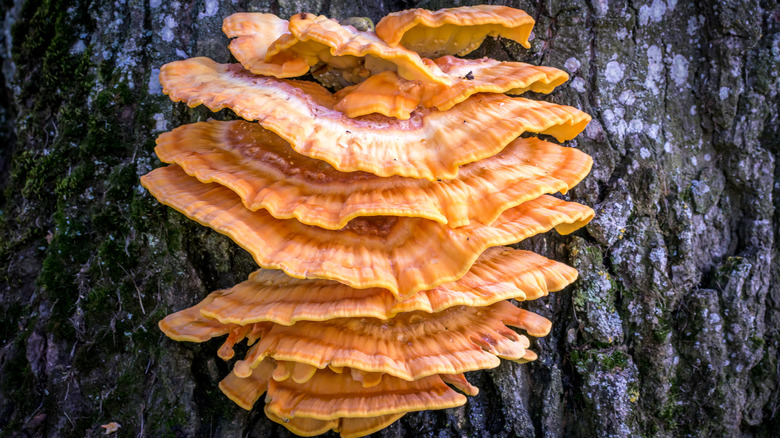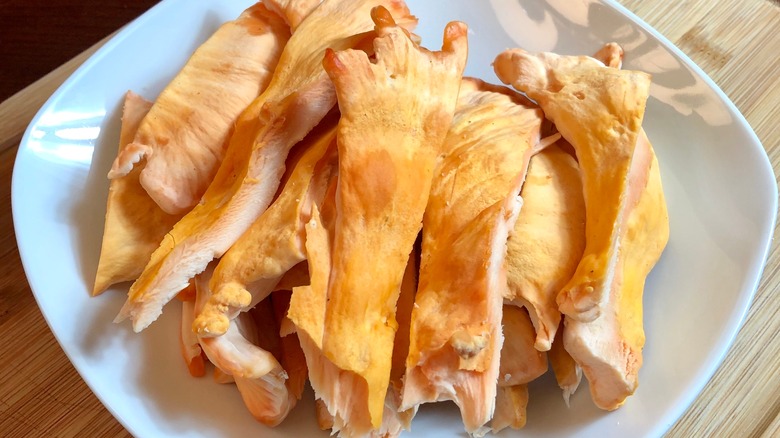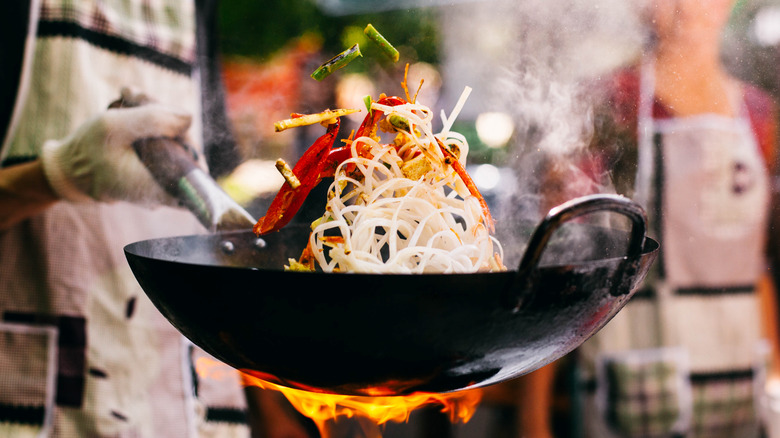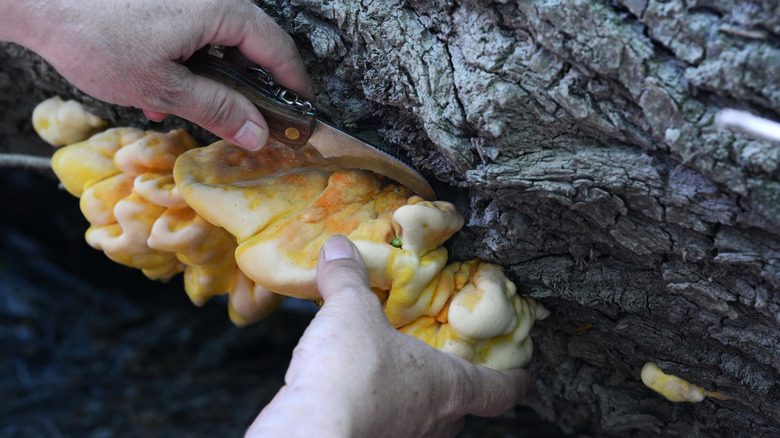The Trendy Chicken Of The Woods Mushroom Is Wooing Carnivores
Although they're not considered a vegetable, mushrooms are natural and plant-based foods, often having what is described as a meaty texture that appeals even to people who love to eat real meat. One such mushroom is the whimsically-named chicken of the woods, a shroom that even the staunchest of carnivores could mistake for chicken itself. The texture certainly mirrors that of the popular white meat, with some agreeing that even the flavor is reminiscent of chicken. Though this may sound similar to the popular hen of the woods mushroom, the two differ greatly in appearance and flavor. Also known as maitake, hen of the woods are gray in color, grow at the base of white and red oak trees, and look more like they are blooming rather than fanning out.
In reality, chicken of the woods is quite neutral in flavor (as is chicken breast, in some regards) so it picks up the flavors of what it's being prepared with very well. Grilled, sautéed, roasted, or deep fried, chicken of the woods mushrooms can truly be prepped just like chicken, offering a delicious, meat-free option to anyone with a taste for poultry.
What are chicken of the woods mushrooms?
Like many desirable mushrooms, chicken of the woods can be difficult to cultivate and farm. They are foraged in the wild for the most part. The varietal is one of the easiest to spot and recognize because of its bright color (orange/yellow-hued), unusual shape, and the fact that it grows solely on trees, not in the ground. It usually grows in clusters or layers that are often quite large and the caps have a wavy shape that fan out on top of each other. If you know your trees, you should take note that chicken of the woods are often found on live or dead hardwood trees like oak and cherry.
There are actually several types of chicken of the woods that grow around the globe, and all but one have a signature orange or yellow color. When they are cooked, these mushrooms have the dense texture that chicken has with a color similar to cooked chicken breast, and a mild flavor; some sense an essence of lemon, crab, or lobster on the taste.
How to cook with chicken of the woods
Just like chicken, this meaty mushroom is incredibly versatile when it comes to cooking. First off, you don't want to eat this mushroom raw, always cook it before consuming. It can be sautéed in stir fries, marinated, grilled and placed in tacos, roasted and put on top of pizza, added to risotto for extra texture, floured and deep fried, or sautéed with olive oil, garlic, and herbs for a tasty side dish. Add them to a cheesy cream sauce for pasta in the winter for a warm, comforting dish.
Like other mushrooms, chicken of the woods is porous and naturally will absorb the flavors around it, so you can make these gems taste like all your favorite marinades and sauces. It also happens to be a very nutritious meat substitute. According to WebMD, these mushrooms are low in calories and fat but high in free radical-fighting antioxidants, and will also give you a boost of protein and carbohydrates.
Where to find them
When you're ready to try chicken of the woods mushrooms for yourself, don't expect to find them at your local supermarket. Your best bet is going to be tracking them down at a farmer's market, specialty market, or an online purveyor. Of course, you can always forage them yourself. If it's your first time mushroom-hunting, it's a good idea to go with someone who knows their wild mushrooms. While chicken of the woods is very recognizable and really can't be mistaken for another kind of mushroom, remember that some mushroom varieties are highly toxic and can make you sick. Be sure you know the ins and outs of foraging before you take the plunge in your own backyard.
The species does have a season which is the late summer to fall, however, it's also not unusual to find them outside of this time frame. Look for the signature signs of the fungi (bright orange or yellow hue, stacked, layered appearance, and growing on trees) to know you've found the right ones. The ones at their peak of flavor will have a clear or yellowish watery liquid on and around them. This is a sign that they are young. When they are mature, they are very tough, chalky, and woody, and are best left for animals and insects to feast on.
When you find them, remember where you are as these beauties tend to come back in the same location every year!




